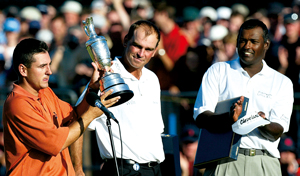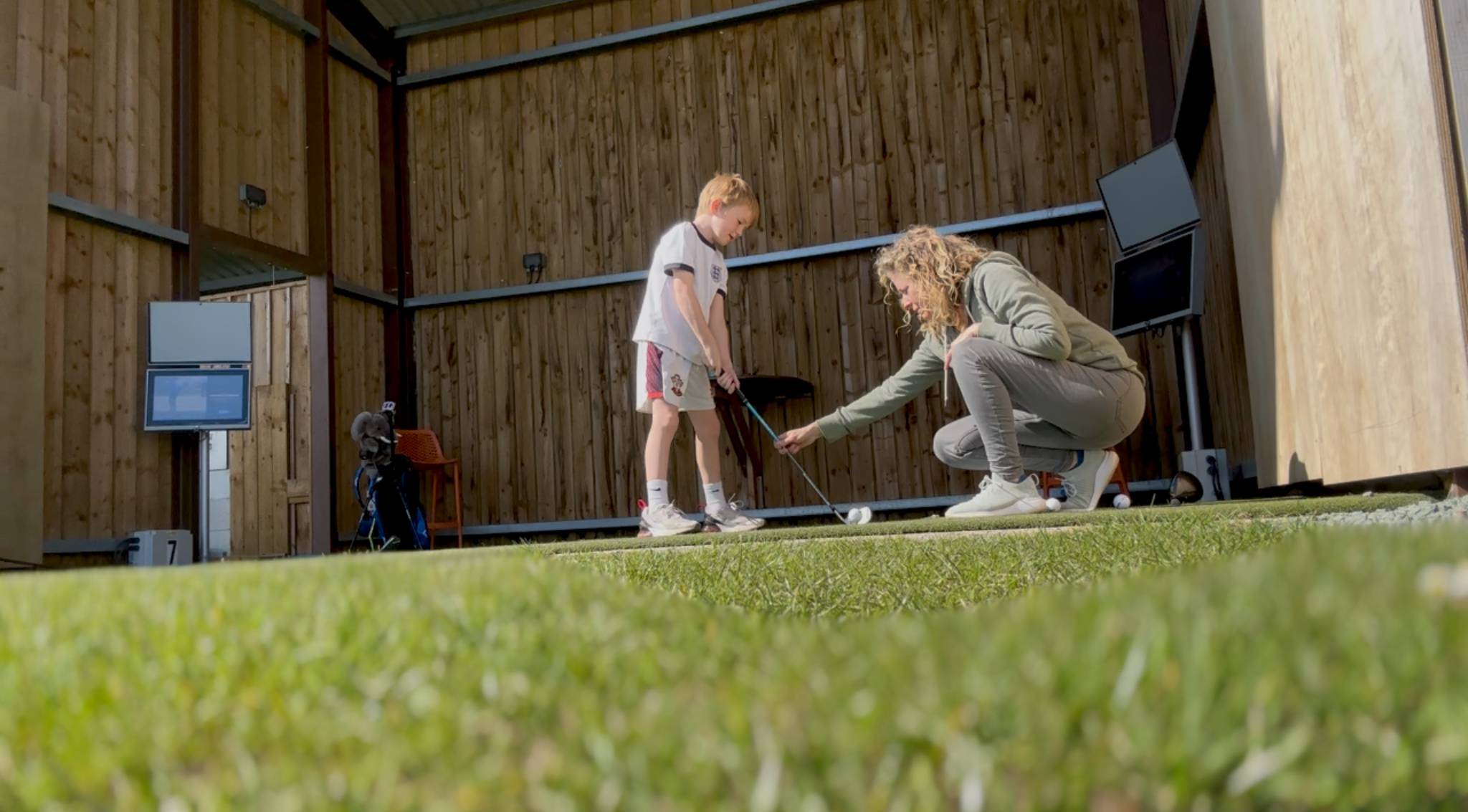Nowhere man
A look back at Ben Curtis' win at Royal St George's in 2003

Any of you guys see which way it went?" From the moment Tiger Woods carved his opening tee shot into the ugly stuff, losing the first ball of his professional career, it was clear that the 132nd Open Championship at Royal St George's was never going to be just another Major Championship.
Yes, the Open's rare sojourn to the Garden of England was typified by some truly bizarre events. Monty pulled out seven holes into his first round having tripped on his way to the breakfast buffet and damaged his wrist. Jerry Kelly needed a calculator (and probably counselling) after one of the worst opening holes in Open history and Mark Roe and Jesper Parnevik were both disqualified for failing to exchange scorecards, which is like any normal person leaving for work without their trousers on. It was that kind of week on the Kent coast. But away from the momentary lapses of reason and the freak buffet-related injuries, there would be one story at Sandwich that would come to top almost any other in modern Major history.
Twenty-six-year old Ben Curtis was a rookie pro on the PGA Tour. Quiet and unassuming, he was born in Jack Nicklaus' town, Colombus, Ohio, and had taken his place on the 2003 PGA Tour after coming straight from the Hooters Tour and Q-School. To say he was an unknown is an understatement. After snatching a starting berth in the field thanks to his best ever finish as a pro - a tied 13th at the Western Open just two weeks earlier - Curtis had rocked up in Sandwich without even a caddie. He was just Ben Curtis, the world's 396th best player.
It must be tough being a pro golfer when you're born in Columbus, Ohio, especially when the other golfer from the city was a bit handy. Not that there was any pressure on Curtis at Sandwich. After all, only the scariest of golf fans would have been able to pick him out of a line-up.
Rank outsider
Certainly, the range of the bookies' odds for Curtis - from 250-1 right up to 750-1 - suggested not just that he had little or no chance of winning at St George's, but also that the bookies, like pretty much everyone else, had no real idea who he was or what he was capable of. It was hardly surprising. Though he had enjoyed a successful amateur career, winning back-to-back Ohio Amateur Championships, Curtis' PGA Tour record since he came through the 2002 Q-School and took his place among the game's elite suggested he was finding life on Tour tougher than he had perhaps imagined.
But for the first two days in Sandwich, Curtis' golf was solid if unspectacular. In short, it was the perfect kind of golf to put him in contention. Two under-the-radar rounds of 72 had left him well placed in a tie for fourth, three shots adrift of the leader, Davis Love III, and just one shot behind South Korea's S K Ho and Denmark's Thomas Björn in second. Given that this was Curtis' first taste of links golf, let alone the Open, it was an assured, almost exemplary showing for one so inexperienced.
Get the Golf Monthly Newsletter
Subscribe to the Golf Monthly newsletter to stay up to date with all the latest tour news, equipment news, reviews, head-to-heads and buyer’s guides from our team of experienced experts.
Part of his success was down to his stand-in caddie, Andy Sutton, who, having caddied for John Bickerton at the Scottish Open the week before, found himself without a bag for the week as Bickerton had failed to qualify for the Open. As he was driving back from Scotland to his home in Kent, Sutton had pulled over and called the management agency IMG to see if any of their players needed a spare hand for the week. "They said they had a guy called Ben Curtis over from the US," he recalls. "I'd never heard of him."
Yet Sutton's experience on the slick greens and rumpled fairways would prove invaluable to the American that week. "When we were practising round the greens I was sticking with a 9-iron to chip, and Andy handed me an 8-iron" said Curtis. "I tried a few chips and it worked so well, I said, ‘I'm chipping with this all week'. He was always there, always supportive and keeping me patient. He was a great help."
Saturday was moving day. As Björn took the third round lead with a classy 69, so the pack behind him staked their claim, with 13 players all within four shots of the Dane and a quartet of four of the biggest names in the game - Woods, Vijay Singh, Kenny Perry and Sergio Garcia - two shots back, joined by Curtis, world number 396. That evening, Björn spoke to the media. Though relaxed, his words belied a certain nervousness. "I haven't been leading a Major this late before," he shrugged. "I don't know yet how to win a Major." The words, so easily thrown, would prove to be prophetic.
Come Sunday, Curtis would arrive looking like any other club golfer at the weekend, wearing an ill-fitting orange polo shirt and a pair of baggy chinos that seemed to have been thrown on at the last minute. Thankfully, his golf that Sunday - at least over the front nine - was far more stylish. He overhauled Björn with ease, collecting six birdies by the 11th hole. The rookie with the buzz cut was five-under par and closing in on an entirely improbably victory. But as the glint from the Claret Jug caught his eye, the scale of what he was about to achieve hit Curtis like a wrecking ball. Four shots would disappear in seven shaky holes, leaving Björn to move back into the lead.
By the 15th, Björn would hold a healthy three-shot advantage with four to play. But if Curtis was doing his level best to make life easier for Björn, so the Dane reciprocated. It was like one of those ‘after you - no, after you' moments when two people are walking through a door. As Curtis threw away shots and his spirited challenged appeared to be wilting in, so it seemed that Björn was intent on gifting the Claret Jug to the American debutant. A dropped shot at the 15th was followed by a double bogey five at the par-3 16th - taking three attempts at extricating himself from the greenside bunker.
Like Jean Van de Velde four years earlier at Carnoustie, it was one of those moments that was so uncomfortable to watch, so excruciating, that you wanted the ground to open up and swallow you as well as Björn. Twice he splashed out and twice his ball stopped on the top of the mound at the side of the green, had a look around and then decided it much preferred the comfort of the bunker. As he stood there in the sand, you knew that here was a player at the end of his tether.
So Björn's round crumbled, and now Curtis was bravely rolling in a tricky eight-foot left-to-righter for par at the last to take the clubhouse lead with a total of 283 - the only score under par, at the time, for the championship. As Curtis left the scorer's hut, he sat and watched the final groups come in on television. One by one they all fell short. Woods only needed to par his last four holes to make a play-off, but bogeyed two of them. Singh was one-under when he dropped a shot at the 16th and then couldn't find a birdie on the final two holes to get him into a shootout. Even Thomas Björn's playing partner, the normally ice cool Love III, faltered when he had a chance of victory, his putter letting him down when he needed it most.
Björn, meanwhile - clearly shaken by the trauma of the previous hole - had squandered another shot at the 428-yard 17th. It had left the Dane standing on the tee at the 18th needing a birdie just to make a play-off. It had been a shocking, almost surreal collapse. When he hit his tee shot at the 15th he had what appeared to be an unassailable three-shot lead and his maiden Major win seemed a formality. He now found himself chasing the game.
As Björn teed off at 18, Curtis retired to the range, hitting a few balls in the event of a play-off. He needn't have bothered. Björn was gone. A par was the best he could manage and as he left the green, his head bowed, it seemed as though he was on the brink of breaking down. If his tie for second at the Open at St Andrews in 2000 - when he finished several light years behind the winner Tiger Woods - was a good week's work, this runners-up spot, grabbed from the jaws of victory, was a professional golfer's worst nightmare. After the event, he was comparatively sanguine about what had happened. "I stood on the 15th tee with one hand on that trophy, and I let it go," he admitted. "You live with it and you move on. I know I have Majors in me." They are Majors that have never materialised, though.
For Ben Curtis, though, it was a victory that had defied reason and belief, and one that sent golf writers scurrying first for the PGA Tour Who's Who and then for the record books. His achievements, it transpired, were astonishing. In winning the Open, he had become the first debutant winner of the event since Tom Watson pipped Jack Newton in a play-off at Carnoustie in 1975 and, incredibly, the first golfer since the amateur Francis Ouimet defeated Harry Vardon and Ted Ray in the US Open at Brookline Country Club in 1913 to win a Major at their very first attempt. Not that Curtis was aware of this. "It's unbelievable," he said at the presentation. "It's the grandest tournament of them all and I'm very fortunate to share the title with all the past winners. I'm going to be up there with the elite. I feel I belong."
The ceremony over, Curtis was corralled into a photocall, sitting on the edge of a bunker by the 18th green. Soon after, his fiancée - the wonderfully named Candace - turned up to join in the celebrations. It was telling that she had turned up for that final day in a denim mini-skirt, faded pink t-shirt and a pair of old trainers, suggesting, perhaps, that she didn't really think she'd be called to take part in any champion golfer's victory parade come the end of the day. Still, with over $1.1 million dollars to take back with them to the Midwest, she could always afford a few trips to the mall.
The world's 396th best player, meanwhile, was now the world's 35th best player. He had won the Claret Jug and a monster cheque, but he'd won a couple of things he couldn't put a price on - recognition and respect. The BBC's Ken Brown perhaps said it best. "Three weeks ago this guy probably wasn't the most famous person in his own house," he concluded. "Now he's Open champion and has the world is at his feet."
-
 I’m A PGA Golf Coach - Here's Why I Made Sure My Kids Can Play Golf
I’m A PGA Golf Coach - Here's Why I Made Sure My Kids Can Play GolfFrom life lessons to lifelong friendships, Top 50 Coach Katie Dawkins on what golf can give your children
By Katie Dawkins
-
 Rory McIlroy's Masters Win More Popular Than Tiger Woods In 2019 As Incredible TV Ratings Released
Rory McIlroy's Masters Win More Popular Than Tiger Woods In 2019 As Incredible TV Ratings ReleasedMcIlroy's role as golf's primary needle-mover continued on Sunday as the Northern Irishman's fifth Major attracted an awful lot of eyeballs in the USA...
By Jonny Leighfield